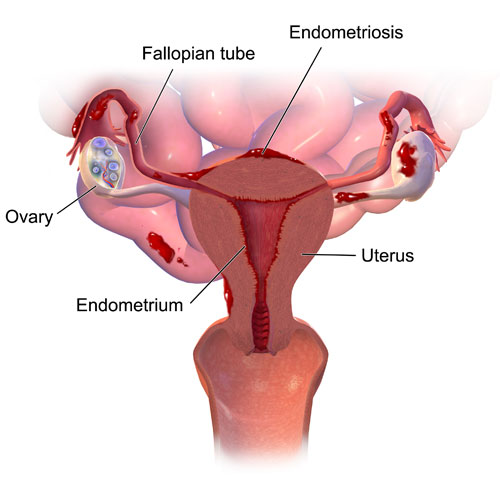Endometriosis
Endometriosis
The name of this condition comes from the word “endometrium,” which is the tissue that lines the uterus. During a woman’s regular menstrual cycle, this tissue builds up and is shed if she does not become pregnant. Women with endometriosis develop tissue that looks and acts like endometrial tissue outside of the uterus, usually on other reproductive organs inside the pelvis or in the abdominal cavity.
Each month, this misplaced tissue responds to the hormonal changes of the menstrual cycle by building up and breaking down just as the endometrium does, resulting in small bleeding inside of the pelvis. This leads to inflammation, swelling and scarring of the normal tissue surrounding the endometriosis implants.
Women with endometriosis are more likely to have infertility or difficulty getting pregnant.

What are the risk factors of endometriosis?
It can develop to any women but the following women seem to be at an increased risk for the disease:
- Women who have a first-degree relative (mother, sister, daughter) with the disease
- Women who are giving birth for the first time after age 30
- Women with an abnormal uterus
What are the symptoms of endometriosis?
Each women may experience different symptoms and some do not experience any. Below are the list of most common symptoms:
- Pain, especially excessive menstrual cramps that may be felt in the abdomen or lower back
- Pain during intercourse
- Abnormal or heavy menstrual flow
- Infertility
- Painful urination during menstrual periods
- Painful bowel movements during menstrual periods
- Other gastrointestinal problems, such as diarrhoea, constipation and/or nausea
How is endometriosis diagnosed?
A doctor evaluates a patient’s medical history especially women facing infertility problems and completes a physical examination, including a pelvic exam. Its definitive diagnosis is through laparoscopy, biopsy of any suspicious tissue and the diagnosis is confirmed by examining the tissue beneath a microscope.
Ultrasound and MRI scan are the other examinations that may be used in the diagnosis of endometriosis.
How is endometriosis treated?
It’s treatment depends on case basis depending on your overall health and medical history, current symptoms, extent of the disease, your tolerance for specific medications, procedures or therapies, expectations for the course of the disease, your opinion or preference and your desire for pregnancy.
Treatment options are:
- “Watchful waiting” to observe the course of the disease
- Pain medication: nonsteroidal anti-inflammatory drugs, such as ibuprofen or other over-the-counter analgesics
- Hormone therapy, including:
- Oral contraceptives, with combined estrogen and progestin (a synthetic form of progesterone) hormones, to prevent ovulation and reduce menstrual flow
- Progestins alone
- Gonadotropin-releasing hormone agonist, which stops ovarian hormone production, creating a sort of “medical menopause”
- Danazol, a synthetic derivative of testosterone (a male hormone)
Surgical techniques include:
- Laparoscopy (also used to help diagnose endometriosis): A minor surgical procedure in which a laparoscope, a thin tube with a lens and a light, is inserted into an incision in the abdominal wall; using the laparoscope to see into the pelvic area, the doctor can often remove the endometrial growths.
- Laparotomy: A more extensive surgery to remove as much of the displaced endometrium as possible without damaging healthy tissue
- Hysterectomy: Surgery to remove the uterus and possibly the ovaries

